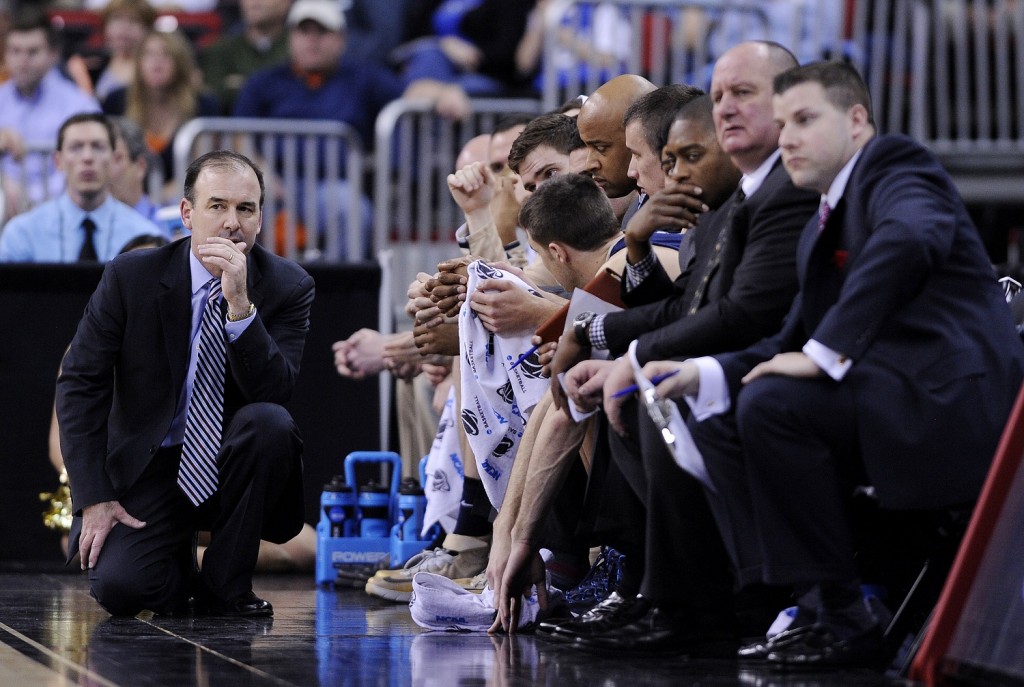WASHINGTON — Deep in the heart of Texas might not be the first place you’d think to look for the most international roster in basketball. But as any NBA fan will tell you, the San Antonio Spurs created the most diverse roster in the league, one that included 10 international players in their 2013-14 championship season, including members from Europe, South America and Australia.
Such a roster seems to make more sense here in Washington, arguably the most internationally diverse city in the United States and home to nearly 180 embassies from countries around the world. At George Washington University, that international diversity and sense of inclusion is exactly what head coach Mike Lonergan has tapped into.
Last year, the program had players from Greece, Serbia and Puerto Rico on the roster, as well as three other internationally born student-athletes. Those three — Kevin Larsen (Denmark), Patricio Garino (Argentina) and Yuta Watanabe (Japan) — all start this season for the Colonials (15-5, 4-3 Atlantic 10), who have already beaten Virginia and have designs on returning to the NCAA Tournament for the second time in three years.
Larsen and Garino are both seniors, leading an experienced starting unit that starts four upperclassmen. The lone sophomore is Watanabe — a lanky, springy 6-foot-8 wing with a reservoir of athletic potential which he has only begun to tap. As just the fourth Japanese-born player to make it at the Division I level and perhaps the one with the best professional potential, he was dubbed the “Chosen One” by the Japan Times.
But he’s also just a college sophomore who arrived in the nation’s capital for the first time speaking almost no English.
“First time I got to U.S., it was so hard,” says Watanabe, who played for a year at the St. Thomas More Preparatory School in Connecticut for one year after high school in Japan.
“I had a hard time, because I couldn’t speak any English. The different culture, different people, it was so hard.”
One thing that made his visit to Foggy Bottom easier was his host, Garino.
“When I visited here, I went to dinner with Pato,” Watanabe recalls, referring to Garino by his nickname.
“I couldn’t talk lots of English, but Pato explained how GW is, as an international college. He told me he had a hard time when he got to the U.S., but that he developed his English and his basketball as well.”
Garino knew exactly what Watanabe was going through, having experienced it himself upon his arrival in the States. He spent his final two years of high school in Florida, but was surrounded by so many Spanish speakers that he didn’t really adjust to the language socially.
“I was trying really hard, but I was really shy,” Garino says. “All my friends were from Latin America or Europe, speaking Spanish the whole time. So the only time I was speaking English was sort of in the classroom and on the court, where I basically knew all the language and everything about basketball in English.”
Thankfully, basketball provides a universal language of physics and motion that transcends native tongues. And Garino found a peer in Larsen who grew up with a similar background in the game.
“With Kevin, knowing that we’re so far away from home, and our cultures are kind of similar, we share a lot of things in common,” Garino says.
“Just knowing that I have a lot of my peers going through the same position, it makes me feel a lot better, too. And also the opportunities that are in D.C. Just going to a new restaurant, or going to the theater. You can absorb so many things from different cultures, and that’s just been fascinating for me to see.”
Lonergan is no stranger to the appeal of the D.C. area. A Bowie, Maryland native, he starred as a point guard at Archbishop Carroll High School and Catholic University, where he later coached the Cardinals to seven straight conference championships and the 2001 D-III national title. He was even an assistant at Maryland for a year before eventually settling at George Washington in 2011.
While GW has featured successful international players as far back as Yink Dare in the early ’90s, in the last couple years since Lonergan has arrived the momentum has really picked up. Each new generation fosters the next one, providing a place where new players can adjust in a supportive environment, allowing them to thrive on the court and off.
“When Yuta came in, we tried to put a big emphasis on making him comfortable, so he could have somebody to talk to who had been through the same thing,” Larsen says. “It kind of gave us a special relationship.”
Watanabe takes it a step further.
“Kevin and Patricio treat me like brothers,” he says.
***

European and South American players often grow up playing a slightly different style of the game, where more focus is put on skill and spacing than on power and athleticism. That approach tends to produce players more like Garino, a 6-foot-6 forward who has the ability to defend, move and shoot like a guard, leading the team with 1.3 steals and 1.1 blocks per game, along with his 44 percent shooting from three-point range.
Larsen, the biggest player on the roster at 6-foot-10, 265 pounds, leads the Colonials in assists. A good number of the best passing big men in the NBA — Marc Gasol (Spain), Boris Diaw (France), Danilo Galinari (Italy), Nene (Brazil) and Andrew Bogut (Australia), to name a few — are internationally born and raised players.
“In Europe, it’s kind of different, because we don’t have the athletes,” Larsen explains. “But in Europe we have more skill guys, and that’s what we focus on. I felt like that gave me an advantage in high school and in college, being so skillful.”
In Larsen and Garino’s sophomore year (2013-14), when both became double digit scorers for the first time, the Colonials jumped from 13 wins to 24, making the NCAA Tournament for the first time since 2007. And as much as both he and Garino were happy to find a place they felt at home, they also chose GW because they thought it was a place they could win.
“Something else that was attractive was that we could come in and build a new program, get it back to where it used to be,” Larsen says.
Success breeds success, and there’s no better way to do that for a college hoops program than with wins on the court. After making the NCAA Tournament in 2014, a quick start fizzled into a disappointing finish and an NIT trip last year. But the Colonials are off to another good start this year, especially at the home away from home that Garino, Larsen and Watanabe have built for themselves at the Smith Center.
In case you forget, the flags are there to remind you. Draped over the rails in front of the student section, the Danish, Japanese and Argentinian colors join the Stars and Stripes, a welcome reminder of the international roster. And lest you think the whole idea of a “second home” is just a cliché, the Colonials are 11-1 and have won 37 of the last 41 on their raucous home floor in Foggy Bottom.
Down 18 to Rhode Island last Friday, the Colonials stormed back to victory as the snowstorm descended outside. Garino hit the shot to put GW ahead for good, with Larsen pitching in nine points and eight boards.
Down 13 to Richmond in the second half Thursday night, Watanabe twice tied the game in the final minutes and the Colonials forced overtime on a desperation three, eventually going to double-OT before dropping their first home loss all season.
Still, it can be tough. Despite great support from one another and the home fans, the trio rarely get to play in front of their families.
“Sometimes I see Tyler (Cavanaugh, from Syracuse, New York) and Joe (McDonald, from Lorton, Virginia)’s families being at every game, and I kind of wish my mom and my brother could be at every game,” Larsen says.
Garino’s mother has made two trips to see him play, but his father’s lone visit to the States was for his high school graduation. He’ll finally get to see his son play for the first time this year.
But both Larsen and Garino had host families from high school who provide an additional layer of support structure, and still come to see them play. Garino also credits his girlfriend and her family for their support. And besides, as Larsen points out, the embassies of all three players are clustered within about an eight block stretch within a mile from campus if they ever need a taste of home.
There’s one other thing that all three have in common which few Americans can claim. Each has played for his respective national team at some level, travelling the world and soaking in the experience. So whether coming to the states for the first time or facing new pressures on the court, each can lean on that experience.
It’s especially true for Garino, who has played with the Argentinian team since he was 15.
“That gave me a little different view about everything – the world, life, basketball, and myself,” he says. “Definitely knowing that I was so young when I was exposed to all those things made that transition easier.”
Watanabe echoes his teammate.
“The whole experience really helped me when I came to the United States,” he says.
With an established track record of success, the foundation is in place for the international student-athletes of the future to find their way at GW. All that’s left now is for Garino, Larsen and Watanabe to leave their mark in March.
“It’s a great program, it’s a great school, it’s in a great city,” Larsen says.
“I think it’s the whole, complete package for an international student to have a great life, a great degree, and especially a great basketball career.”





